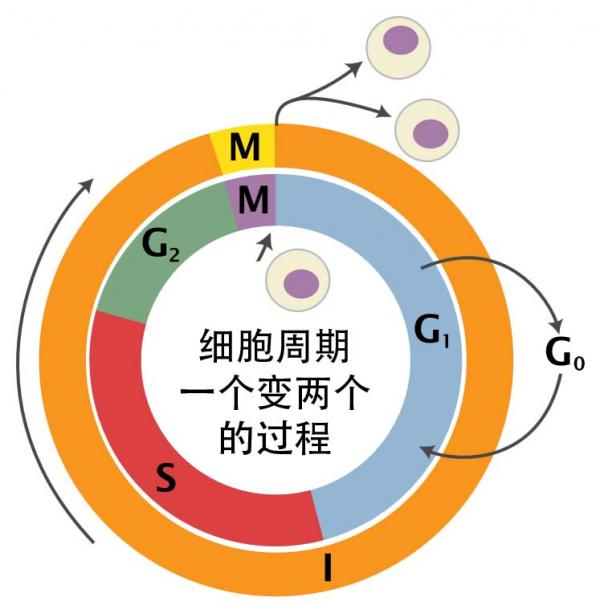》咱知道,这篇翻译小文,太专业化了,没有多少人有兴趣读的。所以翻译了一两年,也从来没有想过要贴出来。也是近来受到有些博主的“批评”和建议,咱的帖子大都是和人打擂台的东东,希望咱也能够贴一些和人打擂台以外的内容。咱也没有什么多的库存,只好把这些东西拿出来顶数量,绝不是有意卖弄。请有心人提意见,如果有不清楚的问题,提出来看看咱能不能答复! 癌症细胞分裂周期再论[译文] [哺乳类动物细胞的分裂,其DNA合成前期(G1)的准备过程极其重要]。调节这个过程的细胞因子发生遗传变异,导致其调节功能的丧失,是绝大多数人类肿瘤产生的原因。[细胞行有丝分裂],有丝分裂原、细胞周期因子D依赖的蛋白激酶(cdk4和cdk6)使视网膜母细胞瘤(Rb)的肿瘤抑制蛋白磷酸化,从而解除这个抑制蛋白对细胞分裂的抑制作用。使E2F等转录因子得以激活那些与细胞合成DNA(S期)的有关的基因,从而使细胞进入分裂周期。 对E2F有反应的下游基因中,主要有细胞周期因子E和A。它们与cdk2结合后便使之受到激活,使细胞加速进入S期,使得细胞周期完成向前的进展。在G1期,随着细胞周期因子D依赖性激酶的累积,它们可以将Cip/Kip等的因子,一组cdk2的抑制物俘获。进一步协调细胞周期因子E-cdk2激活的过程,完成E2F等的转录程序,使得G1-S期的转换成为可能。 “Rb通路”的对细胞分裂的抑制功能可以因Rb因子的突变而失活。另外,细胞周期蛋白依赖性激酶超水平表达,p16INK4a基因的产物表达锐减,一种细胞周期因子D依赖性激酶的抑制因子,也可以起同样的作用。降低p27KIP1因子的表达和增加细胞周期因子E的表达,发生在许多常见的癌症的病例中,常常与不良预后相关。 ARF肿瘤抑制基因,INK4a-ARF位点的替代编码基因产物,受有丝分裂原作用于“Rb通路”的反馈调节。超正常水平的促进生长的刺激因子,可以诱导ARF产生。通过拮抗抵消MDM2的作用,一种p53肿瘤抑制因子的负性调节因子,ARF可触发p53依赖性的转录反应,从而促使初生的癌细胞生长停滞或凋亡。虽然直接损伤DNA,并不直接激活ARF,但是如果ARF的功能丧失,不仅会降低p53应对异常生长信号的抑制反应,也会增加肿瘤细胞对细胞毒性药物和辐射治疗的抵抗力。 p16因子/细胞周期因子D-cdk4/Rb因子以及ARF/Mdm2/p53因子诸环节的功能异常,如果不能说是所有的癌细胞的产生的原因,至少是绝大部分肿瘤的发病原因。这些原因在导致各个年龄段出现肿瘤和产生不同的肿瘤类型,也基本类同。


Cancer Research 60,3689-3695, July 15, 2000 Special Lecture The Pezcoller Lecture: Cancer Cell Cycles Revisited Charles J. Sherr Howard Hughes Medical Institute and Department of Tumor Cell
Biology, St. Jude Children's Hospital,
Memphis, Tennessee 38105 Cell cycle and cancer Genetic lesions that disable key regulators of G1 phase
progression in mammalian cells are present in most human cancers.
Mitogen-dependent, cyclin D-dependent kinases (cdk4 and cdk6) phosphorylate the
retinoblastoma (Rb) tumor suppressor protein, helping to cancel its
growth-inhibitory effects and enabling E2F transcription factors to activate
genes required for entry into the DNA synthetic phase (S) of the cell division
cycle. Among the E2F-responsive genes are cyclins E and A, which
combine with and activate cdk2 to facilitate S phase entry and progression.
Accumulation of cyclin D-dependent kinases during G1 phase sequesters cdk2
inhibitors of the Cip/Kip family, complementing the effects of the E2F
transcriptional program by facilitating cyclin E-cdk2 activation at the G1-S
transition. Disruption of “the Rb pathway” results from direct
mutational inactivation of Rb function, by overexpression of cyclin D dependent
kinases, or through loss of p16INK4a, an inhibitor of the cyclin D-dependent
kinases. Reduction in levels of p27Kip1 and increased expression of cyclin E
also occur and carry a poor prognostic significance in many common forms of
cancer. The ARF tumor suppressor, encoded by an alternative reading
frame of the INK4a-ARF locus, senses “mitogenic current” flowing through the Rb
pathway and is induced by abnormal growth promoting signals. By antagonizing
Mdm2, a negative regulator of the p53 tumor suppressor, ARF triggers a
p53-dependent transcriptional response that diverts incipient cancer cells to
undergo growth arrest or apoptosis. Although ARF is not directly activated by
signals that damage DNA, its loss not only dampens the p53 response to abnormal
mitogenic signals but also renders tumor cells resistant to treatment by
cytotoxic drugs and irradiation. Lesions in the p16/cyclin D/cdk4 / Rb and ARF/Mdm2/p53
pathways occur so frequently in cancer, regardless of patient age or tumor
type, that they appear to be part of the life history of most, if not all,
cancer cells. |
